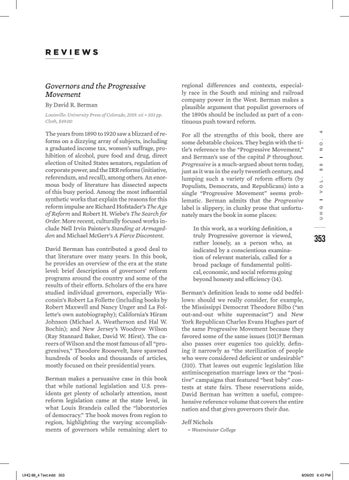REVIEWS
David Berman has contributed a good deal to that literature over many years. In this book, he provides an overview of the era at the state level: brief descriptions of governors’ reform programs around the country and some of the results of their efforts. Scholars of the era have studied individual governors, especially Wisconsin’s Robert La Follette (including books by Robert Maxwell and Nancy Unger and La Follette’s own autobiography); California’s Hiram Johnson (Michael A. Weatherson and Hal W. Bochin); and New Jersey’s Woodrow Wilson (Ray Stannard Baker, David W. Hirst). The careers of Wilson and the most famous of all “progressives,” Theodore Roosevelt, have spawned hundreds of books and thousands of articles, mostly focused on their presidential years. Berman makes a persuasive case in this book that while national legislation and U.S. presidents get plenty of scholarly attention, most reform legislation came at the state level, in what Louis Brandeis called the “laboratories of democracy.” The book moves from region to region, highlighting the varying accomplishments of governors while remaining alert to
UHQ 88_4 Text.indd 353
In this work, as a working definition, a truly Progressive governor is viewed, rather loosely, as a person who, as indicated by a conscientious examination of relevant materials, called for a broad package of fundamental political, economic, and social reforms going beyond honesty and efficiency (14).
4 N O . I
For all the strengths of this book, there are some debatable choices. They begin with the title’s reference to the “Progressive Movement,” and Berman’s use of the capital P throughout. Progressive is a much-argued about term today, just as it was in the early twentieth century, and lumping such a variety of reform efforts (by Populists, Democrats, and Republicans) into a single “Progressive Movement” seems problematic. Berman admits that the Progressive label is slippery, in clunky prose that unfortunately mars the book in some places:
8 8
The years from 1890 to 1920 saw a blizzard of reforms on a dizzying array of subjects, including a graduated income tax, women’s suffrage, prohibition of alcohol, pure food and drug, direct election of United States senators, regulation of corporate power, and the IRR reforms (initiative, referendum, and recall), among others. An enormous body of literature has dissected aspects of this busy period. Among the most influential synthetic works that explain the reasons for this reform impulse are Richard Hofstader’s The Age of Reform and Robert H. Wiebe’s The Search for Order. More recent, culturally focused works include Nell Irvin Painter’s Standing at Armageddon and Michael McGerr’s A Fierce Discontent.
V O L .
Louisville: University Press of Colorado, 2019. xii + 303 pp. Cloth, $49.00
I
By David R. Berman
regional differences and contexts, especially race in the South and mining and railroad company power in the West. Berman makes a plausible argument that populist governors of the 1890s should be included as part of a continuous push toward reform.
U H Q
Governors and the Progressive Movement
353
Berman’s definition leads to some odd bedfellows: should we really consider, for example, the Mississippi Democrat Theodore Bilbo (“an out-and-out white supremacist”) and New York Republican Charles Evans Hughes part of the same Progressive Movement because they favored some of the same issues (101)? Berman also passes over eugenics too quickly, defining it narrowly as “the sterilization of people who were considered deficient or undesirable” (310). That leaves out eugenic legislation like antimiscegenation marriage laws or the “positive” campaigns that featured “best baby” contests at state fairs. These reservations aside, David Berman has written a useful, comprehensive reference volume that covers the entire nation and that gives governors their due. Jeff Nichols − Westminster College
8/26/20 6:43 PM







